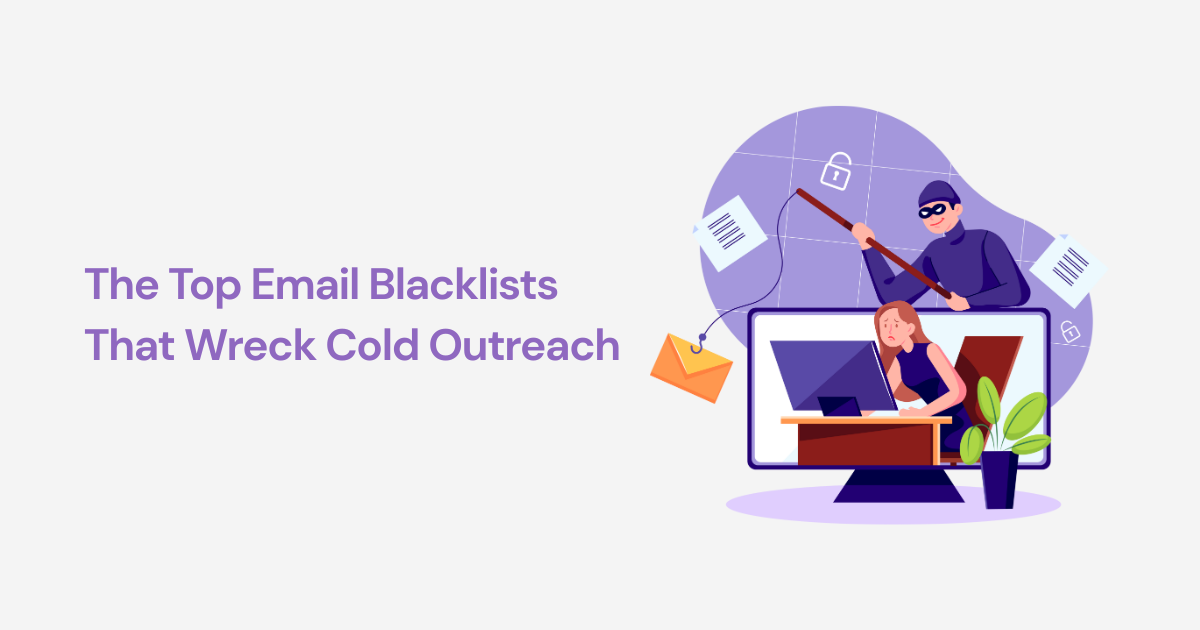
You’re running cold outreach. The leads are solid. The copy is tight. But your campaign metrics are stuck in the mud.
Low open rates. No replies. Bounces creeping up. Sound familiar?
Here’s what most cold emailers miss: deliverability isn’t just about your domain or your message. It’s about whether inbox providers even let your emails through. And if your domain or IP is on a blacklist, the answer is often a quiet, invisible “no.”
In this post, we’ll break down the top email blacklists that impact cold email performance, what triggers them, and how to protect your campaigns from being blocked before they begin.
Email blacklists are real-time databases that flag domains and IP addresses suspected of spammy or malicious behavior.
Inbox providers like Gmail, Outlook, and Yahoo use them to filter incoming emails. If your sending domain or IP shows up on one, your emails are more likely to land in spam, or not get delivered at all.
And here’s the kicker: you’re not always notified when it happens. Your campaign just quietly fails.
Cold outreach already walks a fine line. You're emailing people who didn’t opt in, so mailbox providers scrutinize every signal they can find.
Get flagged for spam once or twice? Fine. But if a blacklist picks it up, you're facing:
One bad send can set you back weeks.
Not all blacklists are equally damaging. Some are minor. Others carry serious weight with email providers.
Here are the top email blacklists cold senders should actively monitor:
If you land on any blacklist, hope it’s not this one.
Spamhaus is one of the most trusted sources used by major inbox providers. Its blocklists power spam filters across Gmail, Outlook, and enterprise email systems.
Triggers:
Stay off it by:
SmartScreen isn't a traditional blacklist, but its impact is just as severe. Microsoft uses it to assess sender reputation across Outlook, Hotmail, and Office365.
Triggers:
Stay off it by:
Cloudmark powers spam filters for several ISPs and mobile providers. If your audience includes people on Verizon, Comcast, or mobile email clients, this one matters.
Triggers:
Stay off it by:
Barracuda’s blacklist is heavily used by corporate firewalls and security tools. If you’re targeting B2B, this one matters.
Triggers:
Stay off it by:
Invaluement maintains three well-respected blacklists and is known for flagging bulk or low-engagement email activity. It’s less widely used than the others, but still dangerous.
Triggers:
Stay off it by:
SpamCop collects user complaints and reports of spam. Enough flags, and you’re listed.
Triggers:
Stay off it by:
The worst part about getting blacklisted? You don’t always notice right away.
You might just see:
It’s a snowball effect. And once it starts, it’s hard to stop.
.png)
Preventing blacklist issues starts with how you build and manage your campaigns. Here's what top cold emailers do differently:
Unverified lists = hard bounces = blacklist risk. Use a dedicated verification tool before every campaign. (Mailivery’s 2-layer verification system checks against 100M+ known bad emails and spam traps.)
Never start cold. Email providers look for consistent, positive engagement. Use a tool like Mailivery to gradually ramp up your sending volume with real, human-like engagement.
Spam filters (and humans) can sniff out mass-produced emails. Personalization doesn’t just help conversions. It protects your sender reputation.
SPF, DKIM, and DMARC aren’t optional. These protocols prove you're a legit sender. Without them, mailbox providers are more likely to block or downgrade your messages.
Watch your open rates, reply rates, bounce rates, and spam complaints. A spike in any of those can trigger a listing.
If you’re on a blacklist, don’t panic, but don’t ignore it either.
Here’s what to do:
Mailivery monitors over 70 blacklists and gives you real-time alerts if your domain or IP is flagged, so you can act before it impacts your business.
Blacklists are invisible until they’re painful.
Mailivery’s Blacklist Monitoring gives you early warning signs, so you never have to wonder why your cold outreach suddenly stopped working.
You’ll get:
Combine it with Mailivery’s warm-up and verification tools, and you’ll have the full infrastructure to stay out of spam, and in the inbox.
👉 Start protecting your domain today with Mailivery
